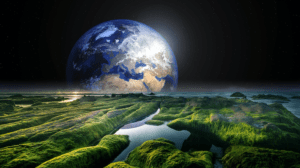What is atmosphere?
When a planet’s gravitational field is strong enough, it becomes completely surrounded by a gas packet or layer of gas. This layer is called the planet’s atmosphere.
A planet without an atmosphere cannot be habitable. That’s because the temperature rises to boiling levels during the day and becomes icy cold at night.

Layers of the atmosphere
As we go higher, air pressure and density decrease. However, air temperature is more complicated to describe. In general, it decreases as we go higher, but in some areas it can remain constant. Based on this and various factors, scientists have classified the atmosphere into different layers.

1.Transforming Sphere.
The troposphere is the lowest layer of air that extends about 12 km from the Earth’s surface and varies in height. For example, near the poles, it is about 9 km high, and near the equator it can go up to 17 km.
This is the densest part of the Earth’s atmosphere and, in fact, contains about 80% of all the mass in our atmosphere. Also, almost all water vapor exists only in the troposphere, and thus, all weather phenomena occur here.
2.Invertible Sphere.
Above the periscope lies the periscope, which extends from 12 km to 55 km. At this height, air pressure drops significantly and near the top of this layer, it is about a thousand times the pressure at sea level.
Jet-powered aircraft can penetrate into the stratosphere, but the conditions in this layer are so stable that weather phenomena do not occur here. Interestingly, since the ozone layer, which absorbs the sun’s UV rays, is located in the stratosphere, the temperature at the top of this layer is much higher due to UV absorption.
3. Mesosphere / Middle Sphere.
From approximately 50 km to 80-85 km lies the mesosphere, which is the coldest place on Earth with an average temperature of (−85∘C).
The mesosphere is so high above the Earth’s surface that even jet-powered aircraft cannot reach it.
No weather phenomena occur here, and there is some kind of cloud in the form of mesohy ice particles. This happens because there is very little water vapor in this layer which condenses due to very low temperatures.
When meteorites reach Earth and enter the atmosphere, they begin to burn up in the mesosphere and do not penetrate the invertosphere. However, very large meteorites can carry it to the surface, causing meteorites to hit Earth.
4. Thermosphere.
The thermosphere is the layer that starts above the mesosphere and reaches a height of nearly a thousand kilometers above the Earth. There is no water vapor or clouds in this layer, but phenomena like the Northern Lights occur here. And remember that the International Space Station and various other satellites orbit the Earth only in this layer. A very interesting thing you should know about the thermosphere is that even though its temperature is about (1500∘C), it does not feel hot to you. This is due to the extremely low density of air in this region.
Another interesting phenomenon is the change in the height of the thermosphere. It is so high above the Earth that it is affected by solar activity and therefore the upper part of the thermosphere is said to be between 500 and 1000 km.
5. The Outer Sphere
The outer sphere is where the Earth’s atmosphere ends. It is the uppermost layer and extends about 10,000 km. At such great distances from the surface, the solar wind exists and the outer sphere merges with it.
Various artificial satellites orbit the Earth in this region as well. The density of this layer is so infinite that many molecules can travel thousands of kilometers without suffering a single collision. In fact, the outer sphere does not behave like a gas, as molecules of gases present in this region often escape into space.
6. Ionosphere
The ionosphere is not a single defined layer of the atmosphere. Instead, the term is used to refer to the part of the atmosphere that is ionized by solar radiation. It includes parts of the upper three layers of the Earth and extends from 50 to 1000 km during the day. At night, the mesosphere is not ionized and is technically no longer part of the ionosphere.
You must remember that the ionosphere is an essential part of the atmosphere when it comes to radio communications. Radio frequencies are reflected by the ionosphere, and without this layer we would not be able to receive radio signals around the world.

Composition of Atmosphere – Gases in atmosphere
The Earth’s atmosphere consists of a large number of gases, the main ones being oxygen, carbon dioxide, nitrogen, argon and various other gases. Nitrogen is the most abundant and makes up about 78.08% of our air. Oxygen makes up 20.95% of our air, while argon and carbon dioxide make up about 0.93% and 0.04% of the atmosphere. Water vapor is also present in the atmosphere, but most of it is concentrated near sea level. Furthermore, the ionosphere contains electrons and various charged atoms and molecules.







